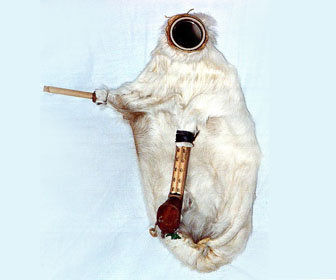 |
 |
| |
|
| |
TULUM | Turkish Folk Instruments

|
| |
The Tulum is a bagpipe-like instrument ,
originating in the Black Sea regions of Anatolia and Bulgaria. With
a blow pipe on top and chanters on the bottom, the Tulum looks and
sounds much like a modern-day bagpipe. Made from sheep or goat hide,
it was commonly treated with nothing more than salt.
According to tradition, a shot glass full of Raki, a homemade
Turkish brandy of high alcohol content, is poured inside the Tulum
after use. Its antiseptic qualities helps prevent the spread of
bacteria and even prevents rot.
|
|
| |
 |
Some of the TULUM songs:
(Click the names for videos of
them.)
Tulum türkü
Child dancer, dances with tulum song
Hemsin great sounds
Tulum - Xoron Horon
Tulum maker
Rize amlakit yaylası
Hemşin - Tulum song and dance
|
|
| |
|
|
| |
The Tulum is a very common bagpipe played in many regions of Turkey.
It is a woodwind instrument. The Tulum has various parts; a Bag
(Post); which is typically made of animal skin; a Blowpipe (Fisaktir)
made of wood or bone; two Flutes or Chanters (Avlos) made of wood;
and two Reeds (Kalame) which are also made of wood.
The Tulum is played by blowing into the blowpipe. The air
blown in is stored in a bag or reservoir; this helps to maintain a
constant flow of sound. The Flute or Chanter produces the melody and
is played by hand. The instrument is held close to one's body,
usually under the armpit, while being played. This position helps
support the instrument and prevent it from falling.
The Tulum produces a very dull, monotonous sound. It's an
extremely loud instrument that will normally be played outdoors.
However, it can also be played indoors. It makes you want to dance
or celebrate, when you hear the unique sound. The Tulum evokes a
feeling of happiness, freedom, and liveliness. The Tulum is used for
entertaining across a variety of events. You will find this
instrument played at some funerals; but mainly parties, festivals,
and other street events throughout Turkey.
The Tulum is one of the most well liked instruments in and
around Turkey; which is why it is a very popular instrument in
several Regions across Turkey. The Tulum is most often played by the
Pontic Greeks as well as the Laz and Hamsheni people.
This instrument can be found chiefly in Hopa, Pazar, Camlihemsin,
Findileli, Hemsin, Ardesen, Arhavi, Anatolia and parts of Artvin and
some villages of Tatos.
The instrument dates back to 1000 BC. It has been modernized
over the years, but not changed completely. Traditional Turkey
Tulums' or bagpipes still have the same shape, style, and function
as older versions. At the turn of the century, the Tulum has been
customized; fashioned by vibrant colors and ornaments. However, it
still maintains its unique sound.
Although it was once a fad of older people, the Tulum has been
scaling down to younger generations in recent years. The Tulum is a
widely used instrument that has been enjoyed by the people of Turkey
for centuries and still is much-admired today.
|
|
| |
|
|
| |
|
|
| |
Other Turkish Instruments:
Baglama
 Classic Kemence
Classic Kemence
 Karadeniz Kemence
Karadeniz Kemence
 Tar
Tar
 Kanun
Kanun
 Darbuka
Darbuka
 Tambur
Tambur
 Ud
Ud
 Zurna
Zurna
 Ney
Ney
 Tulum
Tulum
|
|
| |
|
|
|
<-Back
|
|
 |
|
